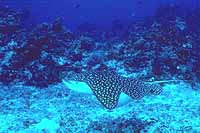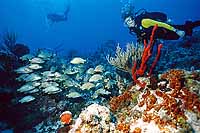Exposure Control with StrobesThe basic goal of using strobes underwater is to provide color-balanced light on the subject. Rarely is the strobe the only source of light. Rather, the strobe should be seen as a brush that paints color onto a subject. Where light from the strobe is present, you will have bright, snappy colors. Where it is not present, colors will be muted and/or blue. If the presence of a strobe is obvious in your picture, you have
probably done something wrong. When used properly, the strobe will light
your scene evenly but almost undetectably--except for the colors, of
course! The first step to making your strobe light work properly is
exposure control, and that's what this section is all about. The basic
goal here is to balance the strobe light with the ambient light. With
wide-angle photography, when there's lots of water in the background, this
is critical. For macro photography, it's not so critical, but is more of a
nicety. Sometimes it's just not feasible to have balanced backgrounds in
macro work.
Exposure Modes: TTL and ManualI'm going to do this section in a sort of backwards way, in the sense that I'm going to cover the more complex method first. The reason for this is that there are a few concepts that you need to understand before we can talk in detail about the simpler method, and those concepts are integral to the more complex method. There are two ways you can control your strobe intensity, namely TTL ("Through The Lens") and manual. In TTL control, the camera controls the strobe, shutting it off when it thinks the film has seen enough light. In manual strobe control, you control the strobe, setting a power level that is appropriate for your picture. Both of these topics are covered in the Exposure 101 section, but some of the concepts are worth repeating just to have a second explanation. If you haven't read Exposure 101, you should probably read it now, just in case. Manual Strobe ControlThe basic idea behind manual strobe control is that you set the aperture, shutter speed, and strobe power to fit your scene. You have information at your disposal that the camera simply does not have, namely the distance between the strobe and the subject, along with the strobe power. You can use this information to nail the exposure perfectly, while the camera has to guesstimate the situation based on parameters programmed into it by the camera designers. Remember the goal here: get a balanced exposure, where the strobe light and background (or "ambient") light are at the same level. Some people like to have the strobe light a little weaker than the background, but that's a personal choice. I'm going to show you how to get them perfectly balanced, and you can fiddle with it yourself if you want a weaker strobe. Here's the overview: you want to meter the water so you know how bright it is. Then you use the strobe-to-subject distance (you'll have to eyeball that yourself, each picture) plus the guide number equation or the strobe's exposure table to figure out a strobe power and aperture combination that makes sense. Then, once you have the aperture set, you pick a shutter speed that exposes the background (water, frequently) at the same level as the subject. Sounds pretty easy, doesn't it? In practice, though, it's a little more complicated. Here's a sort of flow chart of getting good strobe exposure. I commonly go through this at least once on every shot. I shoot all my wide-angle shots in 'A' mode, where I set an aperture and the camera tells me what shutter speed will give me proper exposure for that aperture.
By way of example, it's worth mentioning that the way I shoot most pictures is considerably easier. I put my strobe on 1/4 power and my aperture on f/5.6. Then my strobe's exposure chart tells me that I should be 3.6 feet from my subject. If it's possible to put my subject 3 feet from the camera and get the shot I want, I do so, and shoot (remember 3 apparent feet is actually 4 feet underwater). Underwater, f/5.6 and ISO 100 film almost always results in shutter speeds between 1/125 and 1/250. If it's a bright day, I use 1/2 power and f/8 instead. If I need to move closer (the next distance on the strobe's exposure chart is 2.5 feet), I either go down one power setting on the strobe or close down one stop on the camera. If I'm shooting from father away (5 feet is the next farther setting), I either go one setting higher on strobe power or open up one stop on the lens. Since virtually everything I shoot is between 2.5 and 5 feet, this covers 90% of the pictures I shoot. Anything closer than 2.5 feet or farther than 5 requires the 9-step process outlined above. TTL Strobe ControlTTL strobe control is a method where the camera watches the light build up on the film and shuts off the strobe when it thinks the lighting is right. Read the chapter on TTL strobe usage in the Exposure 101 section if you'd like some more specific information. Basically, though, you expect to use TTL strobe control in only a few cases. Macro work, for instance, is extremely well-suited to TTL strobe control, because you are basically going to light the entire scene from your strobes. In macro work, the goal is to fill the frame with as much of the subject as possible. In this case, you're not worried about balancing the strobe to the background, because there might not be a background! TTL strobe control also generally works well with fish portraits, especially if the subject is a large portion of the frame. If your subject is not a large portion of the frame, though, the camera is going to try to balance the whole picture. Since the light that does not strike the subject goes off into the water, the camera is probably going to let the strobe run longer than necessary--it wants an overall exposure level, so it will let the subject get bright enough until the total light is high enough. The net result of this is usually a bright subject on a dark background, which is not the goal. When you use TTL control, it's still a good idea to pick an aperture that will result in reasonable shutter speeds, a la the 9-step method described for manual strobe control. Just because you're in TTL mode with the strobe, don't forget to make sure the background water is can be balanced with the strobe. You should think of TTL strobe control as relieving you from having to do the strobe-to-subject distance calculation, but nothing else. Balancing the strobe against the ambient light is still your responsibility! Of course, if you decide you want to go to f/32 for your macro shot in order to maximize your depth of field, that's your choice...but be prepared for black water for your background!
|
About | UW Photos | Scuba Picture Uv the Day | Flower Gardens | Aquashot | Trip Reports | RSDiver | Photo Instruction | News | Desktop/Screensaver Images | Site Map |
||


